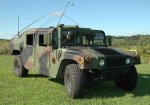Skycop
New member
- 126
- 0
- 0
- Location
- New Braunfels, Texas
Our department is looking at a few HMMWVs on DRMO. Our dilemma is that some of the very clean units have the deep water kits installed and others have the winch installed...of course we can't find any that have both.
Is the winch on the HMMWV like the M35 in that it is PTO driven, or is it an electrical set up? I am trying to decide which units we will want to request and which "accessory" will be the easiest for us to add when we get it here.
Also, with regards to the deep water fording kit, is there anything extra to them other than the breather extension and exhaust extension, or are they like the M35 deep water fording kits that require extra plumbing and such for slobber tubes etc?
Thanks in advance.
Is the winch on the HMMWV like the M35 in that it is PTO driven, or is it an electrical set up? I am trying to decide which units we will want to request and which "accessory" will be the easiest for us to add when we get it here.
Also, with regards to the deep water fording kit, is there anything extra to them other than the breather extension and exhaust extension, or are they like the M35 deep water fording kits that require extra plumbing and such for slobber tubes etc?
Thanks in advance.



